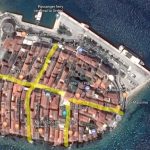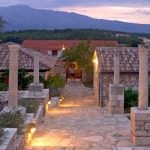Of course, you’re here because it’s an island, the sea, the sun, all the wonderful little islets around, the beaches, maybe even some culture and Moreška, but Korčula really does have a whole different vibe and a very unique experience to offer once you get away from the busy coastline, and we encourage you to take a look inland, to discover all the forests that gave Korčula its ancient name, to see what life used to be like before All Those Tourists came along, to get some authentic food and drinks, especially wine…
1) Žrnovo – a village that consists of several smaller hamlets, within walking distance of the Korčula town is certainly worth a visit. It has a great small-town vibe, it has amazing architecture of narrow stone streets (just wide enough for a car, if you’re lucky), stone buildings on the hill, people still living off their land, and having sheep and goats, several excellent restaurants offering traditional home-made food, wine and other home-made products tasting, wonderful views of the fields in the island centre – this village is an amazing contrast to the busy, flashy, touristy Korčula, place where you should go if you just want to – slow it all down. And see Moštra, less famous sword dance of Korčula, performed in Žrnovo on August 15th, and have some famous Žrnovski Makaruni (macaroni of Žrnovo) hand-made pasta served with beef stew that you should experience on the evening of the so-called Žrnovska makarunijada, one evening in August when Žrnovo becomes the center of Korčula
2) Pupnat – just a little bit further down the road leading from Korčula to Vela Luka on the other side of the island, Pupnat is where you’ll pass by on your way to the famous Pupnatska luka beach (Pupnatska luka actually means “Port of Pupnat”). Don’t just take the left turn on the road, stay for a bit, enjoy walking through the village inhabited by around 500 people, where there’s a restaurant that has managed to obtain a Michelin recommendation (however, that is not the only restaurant in Pupnat worth a visit, as there are several and they all aim to serve home-cooked food from the local ingredients from the Pupnat field), three churches large enough to make you wonder what the village looked like before the emigration wave caused the village to lose most of its inhabitants and a special small-town atmosphere. And if you’re into sword dances, August 5th is the date you should have in your calendar, because that’s when the Kumpanija is performed here!
3&4) Smokvica and Čara – those two central villages have a lot in common, but they are almost 3.5 kilometres apart (an idea for a hike: walk from one to the other, stop at every winery along the way for a tasting, have a designated driver wait for you at your goal!), you can avoid visiting both of them since the new road along the island has been built that bypasses them – but you really shouldn’t, you should go visit the places where the best Pošip and Rukatac wines are grown! Smokvica is somewhat larger, with currently around a thousand inhabitants, but both of those places have some winemaking giants worth a visit. And both have lovely bays nearby, Smokvica is close to lovely Brna and Čara is right next to the amazing Zavalatica, where you can cool off if you’ve tasted one too many of the award-winning white wines of Korčula. If you find yourself on Korčula during the festival Days of Pošip, it would be considered a crime not to visit Smokvica and Čara and experience all that they’re offering.
5) Blato – people from Blato will probably be appropriately mad because we put their little town in the category with all those other… villages. And yes, Blato is a town, named after the mud (literal translation of the name to English) that appears in the field around the town, that has been inhabited since the Roman times. Another one of those numerous places in Dalmatia that lost a large portion of their inhabitants in the twentieth century, especially as a result of the phylloxera which killed most of their vineyards, and although it’s sometimes said that three times more people from Blato live in Sydney today than in Blato, it’s still one of the three largest towns on the island, there’s a high-school in Blato, a lot of agriculture (olives, vines, figs etc.) but also some industry (a small shipyard), the Kumpanija sword dance we mentioned originated here (and can be seen in Blato during summer on several occasions), and in pre-season you can visit the traditional klapa festival in Blato (taking place for almost 4 decades now). And, of course, there’s the amazing linden-tree double tree line, over one kilometer long, right in the centre of the town, a sight that should not be missed!









